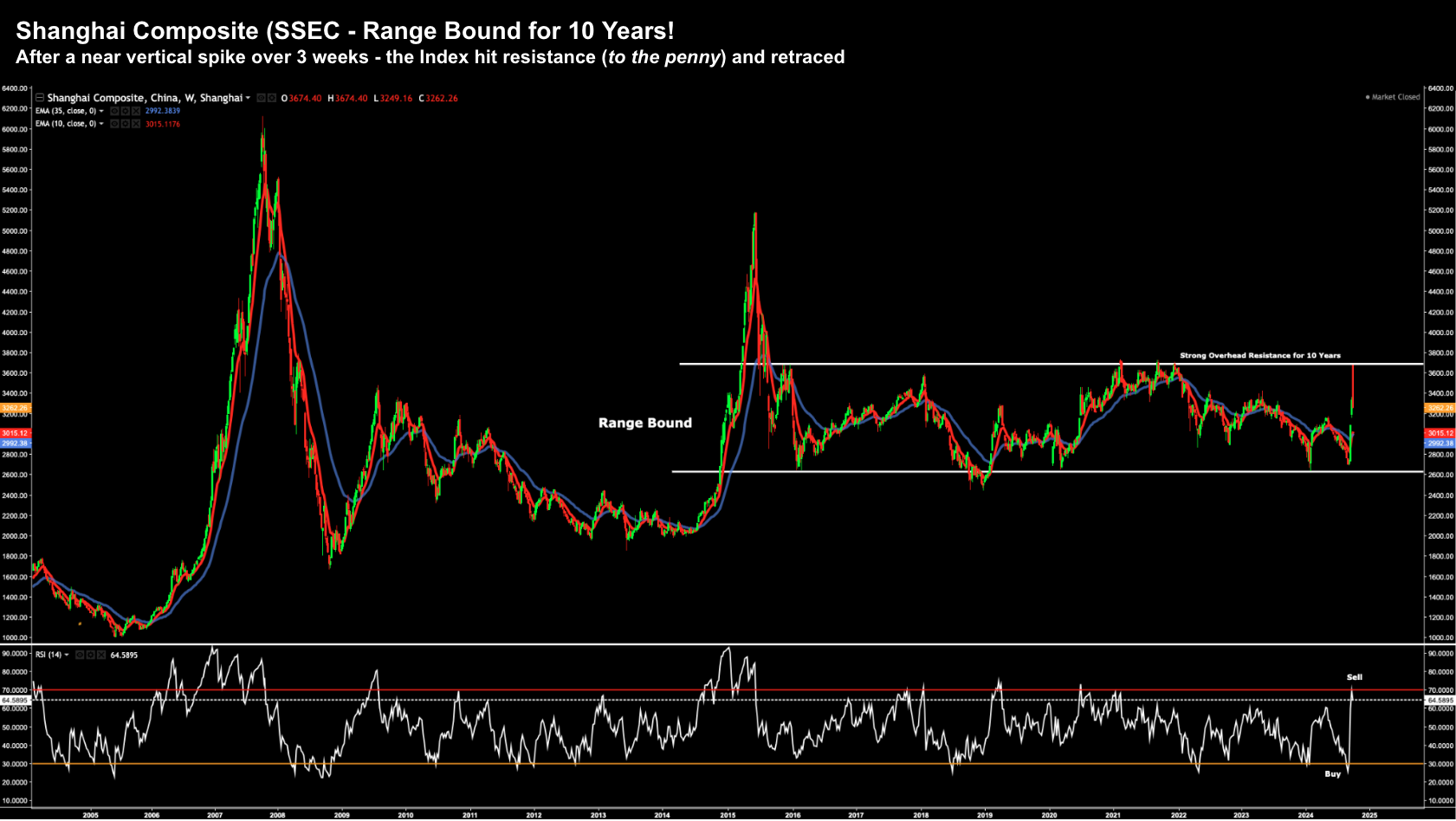Words: 1665; Reading Time: 7 Mins
- Why the rally in Chinese stocks fizzled
- Short-term growth or long-term stability?
- China stocks are investable… with a caveat
The recent rally of over 25% in Chinese was something we’ve not seen in over a decade…
For those who missed it – last Monday – the Shanghai Composite Index surged over 8.1% – its best day in 16 years
Beijing’s ‘stimulus blitz’ excited both institutional and retail investors alike (go deeper).
As context, China has struggled with deflationary pressures due to a prolonged real estate downturn and weakening domestic consumer confidence.
In addition, a slew of economic data in recent months has missed expectations, raising worries the world’s second largest economy may not achieve its 5% full year growth target.
The question is can the central government turn things around with more stimulus?
And if they can – what does this mean for investors?
I remain highly skeptical of short-term measures to fix what are deep, longer-term structural problems (i.e., where excessive debt was misallocated)
Adding more debt (to a debt problem) only compounds the problem.
It fixes nothing.
Yes, in the very short-term, it can give the perception of working.
That’s what stimulus does – a sugar fix.
However, Chinese policy makers face a difficult decision:
Do they focus on longer-term stability (i.e., they reduce debt); or do they prioritize short-term growth targets via more credit?
Choose wisely.
 China’s Credit Addiction
China’s Credit Addiction
The vicious swings in Chinese stocks tells us a lot about what is going on…
Let’s start with a look at the Shanghai Composite
Oct 9 2024
For anyone who has been investing in China the past two decades – it’s been miserable. This 20-year chart tells us (at least) two things:
- The woeful under-performance of Chinese stocks the past 10+ years; and
- The near-vertical surge over the past 3 weeks (and why it met resistance)
But more than this, their Index is also a ‘proxy’ for the difficult choices Chinese authorities face.
For example, it’s clear how desperate investors were for more help.
When it was announced – their stocks surged like it was 2014. For example, approx ten years ago – Chinese authorities announced:
- Massive Fiscal Stimulus: policies to encourage investment in the stock market. This included measures like reducing transaction fees and making it easier for companies to list. There was also a sense that the government would intervene to support the market if necessary, creating a “safety net” for investors
- Monetary Easing: The People’s Bank of China (PBOC) loosened monetary policy to stimulate economic growth. This included lowering interest rates and reserve requirements for banks, which injected liquidity into the market and made it cheaper for investors to borrow money
- Increased Accessibility: The Shanghai-Hong Kong Stock Connect program allowed international investors to access the previously highly restricted “A-share market”
This was all an attempt to attract risk capital and incentivize investors (especially those with money abroad).
And it worked for a brief time… before stocks began reversing.
Which brings us to today…
The subsequent disappointment surrounding the smaller-than-expected fiscal stimulus package underscores the challenges inherent in China’s policy making and its impact on market sentiment.
The Shanghai Composite plunged 6% (from 3358 to 3153) immediately on the news…
All the ‘toys were thrown out of the cot’…. ‘where’s our cheap money?!’
 Investors: Mind the US$400B Gap
Investors: Mind the US$400B Gap
Investors could not have been more disappointed with the central authorities fiscal response.
They were expecting something similar to either 2008 or 2014…
This wasn’t it.
Back of the envelope math suggests it was about 10% of what they hoped.
For example, the powers-that-be announced a 200 billion yuan package (~$28B USD).
But the market was expecting 3 trillion yuan (~$420B USD)
The sharp divergence in investor behavior reflects the growing influence of attracting foreign capital in China’s equity markets.
They depend on it…
But if you want to change investor behavior – you need to examine the incentives.
I’m reminded of my life mentor – Charlie Munger – who gave us these four quotes:
- “Show me the incentive and I will show you the outcome“
- “Never, ever, think about something else when you should be thinking about the power of incentives.“
- “If you want to persuade, appeal to interest, not to reason.”
- “I think I’ve been in the top 5% of my age cohort all my life in understanding the power of incentives, and all my life I’ve underestimated it.”
Charlie shows his humility with this last comment.
Now China has increasingly opened its financial markets to foreign investment – attracting significant inflows.
However, when their leadership changes the investing rules at the drop of hat (as they did with large cap tech recently) – this scares investors.
More on this shortly when I quote Stan Druckenmiller and his views on China (it’s a no touch!)
If you don’t have clear consistent regulatory rules – what’s the incentive to invest?
 Learning from Mistakes
Learning from Mistakes
So why only US$28B vs the US$420B markets were pricing in?
- First, the recent rally in Chinese stocks was the most since 2014 — perhaps sparking worries of an overheating market – in turn creating another boom-and-bust cycle similar to the 2015 episode (as my long-term chart demonstrated).
- Second, central planning authorities are wary of fueling excessive speculation and encouraging unsustainable investment patterns – where capital is grossly misallocated. Again, we saw this in 2015 with a poorly managed currency devaluation, which triggered global market volatility
- Third, by choosing to carefully moderate stimulus – it’s likely an attempt to strike the right balance between supporting short-term growth opposite longer-term stability (the latter is far more important). For example, the authorities are now likely more reluctant to repeat mistakes of 2008 and 2014 – where the unproductive debt still haunts them
 What Matters for Investors
What Matters for Investors
So should you invest in Chinese stocks?
Well it all depends on who you ask.
For example, one of the few investors to challenge the record of Warren Buffett – Stan Druckenmiller – said absolutely not.
Speaking at Grant’s Annual Fall Conference on Tuesday, ‘Druck’ said he has “no interest” in China “as long as Xi Jinping is running” the country.
And I will talk more to this shortly.
My take whilst it might be investible – that comes with a strong caveat.
For example, I treat any bets on Chinese stocks not unlike a long-dated call option.
That is, there is a very high probability of your bet going to zero.
That should be your expectation.
However, if Chinese stocks happen to rise, you could stand to make outsized returns (given their exceptionally low valuations).
Therein lies the key…
Position sizing is important with any investment.
However, if betting on Chinese stocks – it’s critical.
These stocks could go to zero with the stroke of Xi Jinping’s fountain pen (echoing Druck’s point)
But for those who accept the risks – there are several sectors which look interesting. These include (not limited to):
- Macau Casinos
- Internet Platforms (quality names such as Alibaba, JD.com, Tencent, and Pinduoduo)
- Energy; and
- Education
Here I’m looking at several criteria which include the strength of their operating moats, long-term growth prospects, and relative insulation from (excessive) government interference.
The last point is especially difficult to navigate (hence my caution with position sizing). It’s essentially unpredictable.
Pending on what side of the bed Xi Jinping wakes up on… it can lead to a sudden shift in attitude towards investors.
And in that sense – it’s not unlike a snake pit.
Be prepared to be bitten.
As an investor, that doesn’t sit well with me.
My guess is this is why Druckenmiller (among others) won’t touch Chinese stocks – he does not like the (government policy) risks which come with it.
To mitigate the downside, I limit my position sizing to any single Chinese stock to a maximum of 1% of my total risk capital.
Again, I see it like a long-term call option on the assumption I will likely lose the 1%.
However, if China operated under the same regulatory rules as say the U.S. (something it would never do – given its totalitarian rule) – sure – I would be willing to invest a lot more in some of these high quality (and cheaply valued) companies.
But I just can’t…
I can recover easily from a 1% total loss… but it’s much harder to recover from say a 20%+ loss.
Putting it All Together
China’s recent stimulus measures highlight the difficult choices they must make.
For over a decade, the one-trick pony of excessive stimulus has given the appearance of working.
That’s what stimulus does. It gives the economy (and markets) a sugar hit.
There’s just one problem:
Throwing more debt at a debt problem doesn’t fix anything.
Yes, China does have long-term growth potential (as do other countries – such as India). And many of their businesses (like Alibaba, Tencent, JD.com) are exceptionally good value.
But that’s not what we’re debating…
It’s the administration of Xi Jinping.
Chinese authorities need to fix this problem and give investors (like Druck) the confidence to invest in their markets.
Start by removing the snakes.
The game is hard enough to pick stocks which will beat the market. It’s another thing entirely to navigate an administration who cannot be trusted.
If investing in China… do so with money you’re prepared to part with.
Side Note on U.S. Bonds:
- As part of Druck’s presentation – he added he’s short US bonds with 15% to 20% of his portfolio.
- He said he did not know whether the bond trade would take six months or six years to play out.
- Nor did he give guidance on how he’s shorting bonds (e.g. durations).
- The basis for expecting yields to rise sharply is “bipartisan fiscal recklessness is on the horizon”
Could not agree more (although I would suggest it’s already here).
I’ve been on this train for sometime…
This is my primary concern if holding long duration bonds and why I suggested taking profits with the 10-year well below 4.0% (e.g. if you own EDV or TLT)
I see these yields appreciably higher over the next few years (but not necessarily over the next 12 months)

